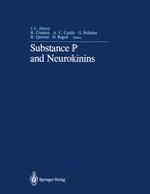1987 | OriginalPaper | Buchkapitel
Pharmacological Modulation of Antidromic Vasodilatation Measured by Laser Doppler Flowmetry
verfasst von : R. Gamse, A. Saria
Erschienen in: Substance P and Neurokinins
Verlag: Springer New York
Enthalten in: Professional Book Archive
Aktivieren Sie unsere intelligente Suche, um passende Fachinhalte oder Patente zu finden.
Wählen Sie Textabschnitte aus um mit Künstlicher Intelligenz passenden Patente zu finden. powered by
Markieren Sie Textabschnitte, um KI-gestützt weitere passende Inhalte zu finden. powered by
Antidromic electrical stimulation of dorsal roots or sensory nerves causes vasodilatation presumably by the release of sensory neuropeptides [see 5]. Various methods have been used to study antidromic vasodilatation (AVD) in the rat, e.g. collection of venous outflow after stimulation of the saphenous [5] or mental nerve [1] or measurement of iodide disappearance rate from the dental pulp [2]. Data obtained by these methods suggest that AVD is modulated by pre junctional opiate receptors [4,6] and may in part involve histamine release from mast cells [1,5]. The involvement of histamine is controversial, as is the inhibitory effect of atropine [1,2,5]. We, therefore, reexamined the pharmacological modulation of AVD using the non-invasive technique of Laser Doppler flowmetry (LDF). Since this technique measures the velocity of moving blood cells, an increase of velocity can be interpreted as an increase in blood flow. The usefulness of LDF for studying blood flow has been demonstrated for various tissues including the skin [3,7].
